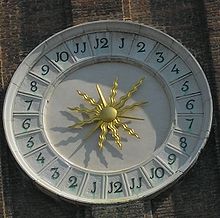Wikipedia:Reference desk/Archives/Language/2023 November 21
| Language desk | ||
|---|---|---|
| < November 20 | << Oct | November | Dec >> | November 22 > |
| Welcome to the Wikipedia Language Reference Desk Archives |
|---|
| The page you are currently viewing is a transcluded archive page. While you can leave answers for any questions shown below, please ask new questions on one of the current reference desk pages. |
November 21
[edit]Use of capital "J" as a substitute for the digit "I"
[edit]
Hello, I'm looking for a reference to cite in the article 1#As a digit regarding the use of the capital letter "J" as a substitute for the Roman numeral I. An example is shown in this image of a clock in Venice. The only information that I can find is this blog post where it appears lower it arises from the lower-case "j" swash variant of i. I'd really appreciate a reliable source for this! Thanks Polyamorph (talk) 09:31, 21 November 2023 (UTC)
- @Polyamorph: The clock in your picture does not have Roman numerals. I think you mean Arabic numeral 1. There is some reference to your suggestion at J#History. Bazza (talk) 10:10, 21 November 2023 (UTC)
- Thanks @Bazza 7: ah yes, sorry I wasn't clear. It is representing the Arabic numeral 1 but the origin seems to be from it's use as a Roman numeral. Or this might be pure speculation. In the article you cite it states:
The letter J used to be used as the swash letter I, used for the letter I at the end of Roman numerals when following another I, as in XXIIJ or xxiij instead of XXIII or xxiii for the Roman numeral twenty-three.
but this is not explicitly referenced. Is there a source for this? Polyamorph (talk) 10:14, 21 November 2023 (UTC)- @Polyamorph: A nice diversion for this morning! Roman_numerals#Use_in_the_Middle_Ages_and_Renaissance has a bit more, including a 13th century sample for "iiij", which predates the referenced emergence of "J" as a separate latter in my earlier link. However, your original requirement was for a definitive reference that states "J" is just a fancy rendition of "I" in such circumstances, and on that I have drawn a blank (so far). Bazza (talk) 10:41, 21 November 2023 (UTC)
- @Bazza 7: thanks for looking, and I'm glad you enjoyed the distraction! Polyamorph (talk) 19:21, 21 November 2023 (UTC)
- @Polyamorph: A nice diversion for this morning! Roman_numerals#Use_in_the_Middle_Ages_and_Renaissance has a bit more, including a 13th century sample for "iiij", which predates the referenced emergence of "J" as a separate latter in my earlier link. However, your original requirement was for a definitive reference that states "J" is just a fancy rendition of "I" in such circumstances, and on that I have drawn a blank (so far). Bazza (talk) 10:41, 21 November 2023 (UTC)
- Thanks @Bazza 7: ah yes, sorry I wasn't clear. It is representing the Arabic numeral 1 but the origin seems to be from it's use as a Roman numeral. Or this might be pure speculation. In the article you cite it states:
- Before the 17th century, "I" and "J" were the same letter (as also "U" and "V"). AnonMoos (talk) 11:10, 21 November 2023 (UTC)
- There were certain typographical conventions, though, like using a majuscule V but a minuscule u: Love’s Labovr lost[1] versus Loues Labour’s loſt[2] – but not quite consistently: see the coexistence of uiſa and valle on this title page. I don't know when a typographical (not orthographic) majuscule J made its appearance. --Lambiam 14:22, 21 November 2023 (UTC)
- @AnonMoos and Lambiam: Ah, Ok. The sentence I'm trying to source reads:
"Occasionally, the uppercase J may have been used as a substitute for the numeral I.[citation needed]"
. I want to provide a citation. I have references for the use of the lower case j in the place of i, particularly as as the final numeral to prevent forgery. But I can't find a suitable reference for the capital J in the context of numerals. It doesn't necessarily have to explain that clock which combines J with the Arabic numerals, since that might be obscure use limited to the particular locale in Venice. Polyamorph (talk) 19:47, 21 November 2023 (UTC)- The only examples I can find of upper case Roman numerals IIJ, VIIJ, XIJ etc., like here, are from a period when orthographically the use of ⟨j⟩ as a letter in a word was already reserved for the consonant or semi-vowel. So these are clearly upper-case versions of the much more common iij, viij, xij etc. --Lambiam 22:40, 21 November 2023 (UTC)
- This has been discussed previously at least once: Wikipedia:Reference desk/Archives/Humanities/2014 June 1#Mysterious symbols. -- Jack of Oz [pleasantries] 18:54, 21 November 2023 (UTC)
- The clock face is not a unique use of a J for the Arabic numeral digit 1. I found quite a few more,[3][4][5] and even uses of a minuscule j, as in 9·j0·jj·j2.[6] --Lambiam 14:03, 22 November 2023 (UTC)
- Amazing, impressive research skills! Polyamorph (talk) 23:29, 22 November 2023 (UTC)
Inverted exclamation mark
[edit]| banned user |
|---|
| The following discussion has been closed. Please do not modify it. |
|
I don't usually read the i newspaper, but last Thursday I did. I see that it has a puzzle pullout section in the middle. So last night I turned to the "Word Ladder". The instructions read:
My solution was SOME>SAME>SANE>SANK>WA*K>WALK. Rather surprised at this, I turned to the solutions on page 48, which gave SOME>SAME>SALE>TALE>TALK>WALK. My first effort got to SOME>SAME>SALE before I got stuck. Do the setters consider all the different words solvers might come up with before submitting their puzzles for publication in a family newspaper? 2A02:C7B:301:3D00:9050:32D9:B298:5C82 (talk) 19:20, 21 November 2023 (UTC)
|
